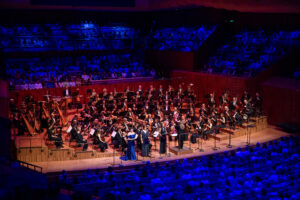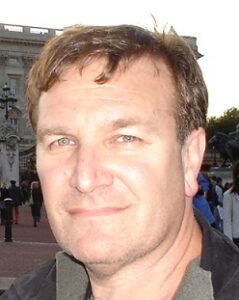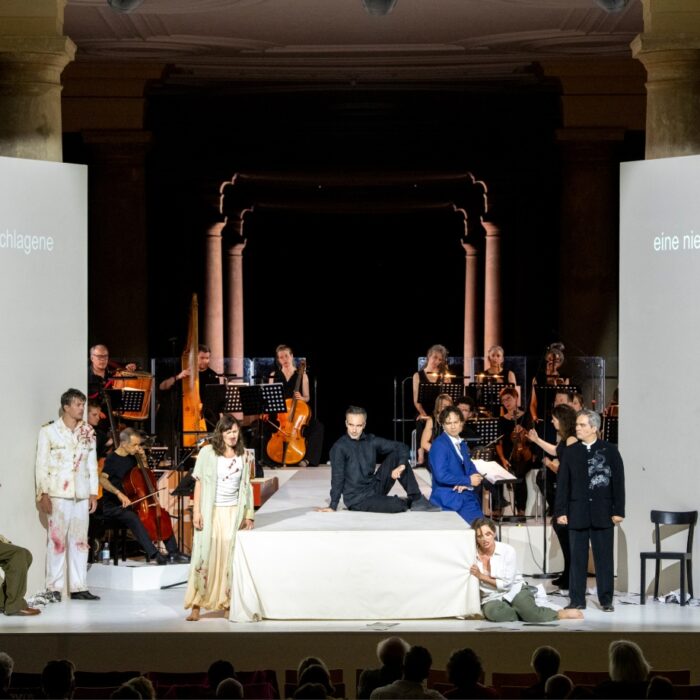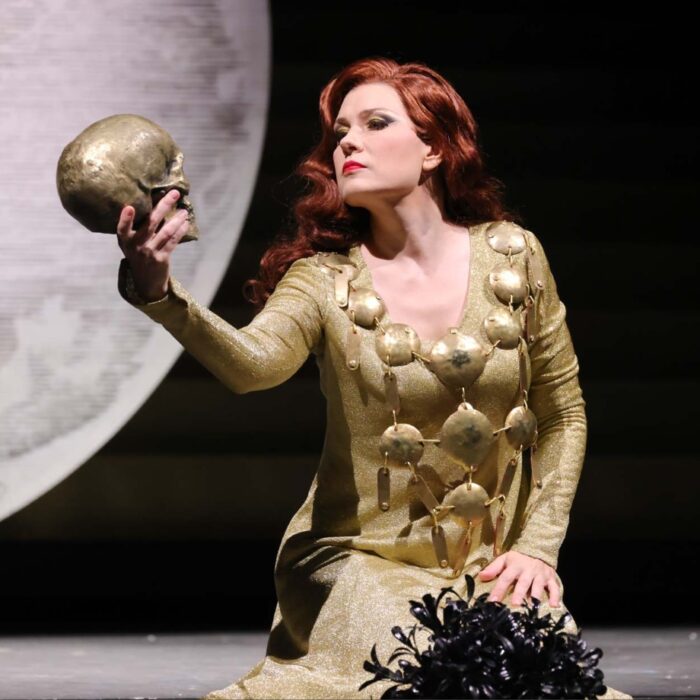
Sydney Symphony Orchestra 2023 Review: Das Rheingold
By Gordon Williams(Photo credit: Daniel Boud)
Concert performances of “Das Rheingold” by the Sydney Symphony Orchestra (SSO) in the Opera House Concert Hall November 16-18 were the most recent events in what is shaping up to be a bit of a Wagner year in Australia. Next month sees Opera Australia’s much-awaited new “Ring cycle” in Brisbane, delayed twice previously by COVID. Back in April, Melbourne Opera gave the cycle’s first airing in regional Australia, 95 miles northwest of Melbourne in the gold rush city of Bendigo.
These Sydney Opera House performances, conducted by the SSO’s current Chief Conductor, the Australian Simone Young, previously General Manager and Music Director of the Hamburg State Opera, marked the beginning of a multi-year “Ring” cycle to be given in concert by the SSO.
In 1995, the SSO began a multi-year cycle under then-Chief Conductor, Edo de Waart and ending in the Olympics year of 2000 with “Götterdämmerung.” These, too, were concert performances. In fact, the Sydney Opera House has never seen a fully-staged cycle and, according to research by Merylyn Russell, Sydney itself has not seen a fully-staged “Ring” since Thomas Quinlan brought his 200-strong English company out here in 1913.
But according to the SSO’s recent publicity, Wagner’s vision should be experienced “ideally, as a purely musical performance”. Playwright and Wagnerite George Bernard Shaw also preferred the “Ring” “without looking.”
There are people, of course, who only finally warm to Wagner after seeing the surtitles and being able to follow the expert dramatist’s efficiently –plotted story – of an ugly elf Alberich who renounces love to gain the Rhine’s gold after being rejected by the Rhinemaidens; of the god Wotan who nabs the gold to pay off the giants who were initially offered the goddess of youth, Freia, as payment for building the gods’ citadel; of Wotan trying to hold onto the ring made from that gold even after Alberich has cursed it, until Erda, the Earth Goddess, warns him to give it up; of the gods’ blindly triumphal entry into their citadel, Valhalla, even after seeing the bloodshed the ring has set in train…one could argue that one might lose the full massive irony of the ending, entering into Valhalla, if you haven’t actually seen the gods ignore the dead body of Fasolt, first victim of the ring’s curse, murdered by his gold-coveting brother, Fafner.
Compelling, Beat By Dramatic Beat
So, what was this concert performance like? Even with its pronounced focus on the musical side of Wagner’s Gesamtkunstwerk, or total work of art, it was compelling, beat by dramatic beat.
By and large, it sounded beautiful. This is not to note any downplaying of rhetorical gesture, but as an example, the entry of the gods into Valhalla had a richness that stood in contrast to bombastic presentations that are possible for this supposedly triumphal ending – emphasis on an ample bass, maybe, rather than mere volume. And so many of the quiet moments were spellbinding – the entry of the 8th horn, played by Lee Wadenpfuhl, in the primeval opening on the bed of the Rhine, the beautiful voicing of strings and timpani as the gods re-entered in Scene four to learn Freia’s ultimate fate, the glowing emergence of the “tarnhelm” motif on each of its appearances highlighting its oblique harmony but also its eerie transformative qualities.
One advantage of seeing the orchestra rather than costumed singers framed by sets and a director’s attempt to match Wagner’s vision, was corroborating the importance of Wagner’s orchestra and observing the musicians’ dramatic contribution – the churning energy of the violas, for example, at key moments. Or seeing the Wagner Tubists pick up their instruments and anticipating the unique sound that’s about to come out. The orchestra provided its own “set-ups and pay-offs.”
This performance was the work of a conductor whose musical vision for the “Ring” transmuted into drama. The score was beautiful to listen to in its own right but telling, dramatically. The varying volumes of Young’s climaxes or her use of silence created their own plotline – the shrill exit on Alberich’s “mein Fluch,” the extra-loud dissonant 13th chord maximizing the tension Wotan will release when he finally invites his wife, Fricka in “Folge mir, Frau!,” into the newly-built, hard-won, but compromised citadel. Such were the pylons of Young’s impressive structure.
Of course, once one personifies the characters, one might have an act of theater engaged, to borrow from Peter Brook’s observation. And so, there was a modicum of theater once singers stood in front of the orchestra.
Modicum of Theater
As the Rhinemaidens, Australian/British soprano Samantha Clarke as Woglinde, Australian mezzo-soprano Catherine Carby as Wellgunde and Australian mezzo-soprano Margaret Plummer as Flosshilde, added just enough gestural detail to complement the vocal differentiation of their trio. On the other hand, the delightful blend of their combined voices symbolized their essential camaraderie when, for example, the gold they are meant to be guarding is threatened by the loathsome Alberich. There was even something thrilling about their extolling of the “Rhine Gold.”
Alberich is not king of the gods but German bass-baritone, Falk Struckmann possessed a nobility of voice that marked him appropriately as the equal opposite in power to Wotan, who elsewhere in the “Ring” cycle is referred to as “Light Alberich.” Struckmann’s Alberich was dastardly, yes – but able to rise to a kingly par. The range of his performance was enjoyable. You could virtually hear the passion burning, swelling through his breast in “schwellende Brust” as he longed for those taunting Rhinemaidens.
Perhaps of all the roles, Fricka, Wotan’s wife, offers her singer an actorly satisfaction. German mezzo-soprano Michaela Schuster made much of her lyrical moments but it was in her many telling recitatives that Fricka’s common sense pierced through Wotan’s smug authority and the rash error he has made in offering Freia as payment.
German baritone Wolfgang Koch offered the overall presentation a strong center of gravity as Wotan. At times there was a clever matching of Struckmann’s tone, but there were enough flashes of powerful anger, “Halt, du Wilder!”, and effectively-delivered reflective asides, such as when he cottons on to the fact that he has heard of this gold, to show the beginning of that human consciousness which will make Wotan such a fascinating character later in the cycle. Koch’s “Von des Rheines Gold hört’ ich raunen” arose as if from out of nowhere.
Scene two also sees the other gods assemble to lament the possible loss of Freia. Australian soprano Eleanor Lyons conveyed Freia’s palpable fear of being taken into domestic slavery by the giants. New Zealand heldentenor Simon O’Neill was an impetuous, almost comically-rash god of joy, Froh; and Samuel Dundas as Donner, a hot-headed thunder god.
As Fasolt and Fafner, Australian baritone Simon Meadows and New Zealand-born bass Jud Arthur nicely differentiated their portrayals of these brother-giants. Meadows conveyed a quality of homespun wisdom and a touching sense of justice in the delivery of his lines, for example the briskness of “What you are, you are by bargains,” admonishing Wotan. Fafner has no such idealism and in his murderous usurpation and confiscation of the ring at the end – “an den Reif rührst du nicht mehr,” the elongated vowel on Arthur’s “mehr,” opening into an “ah,” virtually allowed the audience to look down the mouth of the gold-hoarding dragon Fafner will transform himself into, in Act two of “Siegfried.”
Australian tenor Andrew Goodwin was a perfectly simpering, put-upon Mime, bullied by his brother Alberich into making the “tarnhelm.” But Goodwin might have reminded one that Mime, also, has his lyricism, as in his account of how Alberich stole the gold. As Erda, Israeli contralto Noa Beinart, exhibited a regal tone to match the physical fact that she towered over everyone else in the cast.
Perhaps it is the constantly underestimated god of fire, Loge, charged with urgently finding an alternative payment to Freia, who is the character closest to Wagner’s authorial voice. It is he who makes clear that the gods’ entry into Valhalla is not the happy ending it looks to be.
Australian tenor Steve Davislim acquitted this responsibility well, providing a variegated performance that appropriately matched Loge’s constantly flickering spirit of negotiation. He could deliver the beauty of a phrase about “woman’s beauty and worth” in his “Immer undank” narration or paint a picture of Fasolt and Fafner striding off with Freia, while maintaining a kind of insouciant unaffectedness. When he suggested that Wotan could get the gold off Alberich “by theft,” audience-members laughed. Delivering the phrase breezily conveyed a breathtaking disregard for fairness or anyone’s feelings, least of all Alberich’s, that earned grudging admiration of the character’s brazen-ness. It was not a sense you might get with a more obvious emphasis.
Musical Revelation
Overall, the musical presentation worked. Yes, there were also a few visual prompts. The performance began in darkness with just a glow at the tip of Young’s baton visible. Would it be too fanciful to think of this as the glow of the Rhine’s as yet-undisturbed gold in its cleft in the river’s depths? A few other lighting changes provided visual clues.
But other stagey devices held musical revelation. Toward the end, the Rhinemaidens singing offstage in the eastern hallway accompanied by Louise Johnson’s glittering harp was a highlight. Were we meant to think: “Of course, these mermaid-like creatures would lament the loss of their gold to the accompaniment of a harp!” But it was one of those moments when you could be grateful for not having to see a director’s attempt to represent aquatic creatures – just admire Wagner’s musical advocacy.
So, is a concert the best way to experience Wagner’s work?
Many Australian Wagnerites know of the letter Wagner wrote in 1877 to a Mr. Emil Sander in Melbourne stressing that he wanted his operas performed in English in English-speaking countries because “only in this way can they be intimately understood by an English-speaking audience.” Wagner himself wanted us to be conscious of the words, word-by-word? Is it not the total work of art without this?
But actually there are so many aspects of Wagner to become acquainted with that one might become intimately acquainted with one aspect at enough depth to enjoy a total artistic experience. Certainly with the music.
Another way to look at it is to realize, as did Heinrich Porges who witnessed Wagner’s rehearsals for the first “Ring” in 1876 that Wagner was a Gesamtschauspieler, a total actor. And, surely, it was the orchestra and the musical score that he used for his gestures and inflections. Rather in the way Young did!



